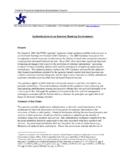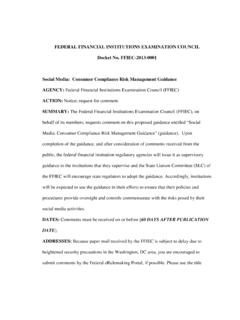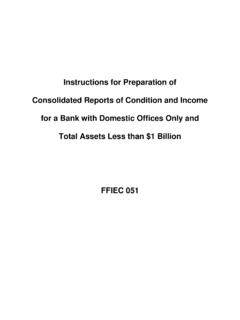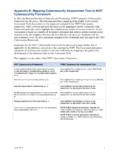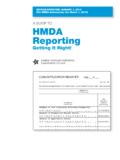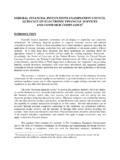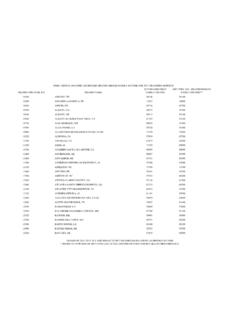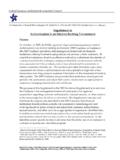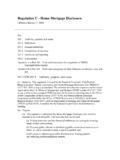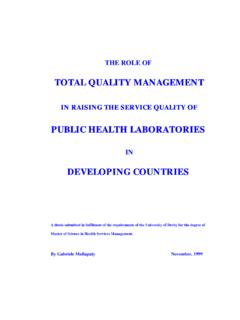Transcription of INTERAGENCY ADVISORY ON - FFIEC Home Page
1 1 ADVISORY ON INTEREST RATE RISK management January 6, 2010 The financial regulators1 are issuing this ADVISORY to remind institutions of supervisory expectations regarding sound practices for managing interest rate risk (IRR). In the current environment of historically low short-term interest rates, it is important for institutions to have robust processes for measuring and, where necessary, mitigating their exposure to potential increases in interest rates. Current financial market and economic conditions present significant risk management challenges to institutions of all sizes. For a number of institutions, increased loan losses and sharp declines in the values of some securities portfolios are placing downward pressure on capital and earnings.
2 In this challenging environment, funding longer-term assets with shorter-term liabilities can generate earnings, but also poses risks to an institution s capital and earnings. The regulators recognize that some degree of IRR is inherent in the business of banking. At the same time, however, institutions2 are expected to have sound risk management practices in place to measure, monitor, and control IRR exposures. Accordingly, each of the financial regulators have established guidance on the topic of IRR management (see Appendix A). Although the specific guidance issued and the oversight and surveillance mechanisms used by the regulators may differ, supervisory expectations for sound IRR management are broadly consistent.
3 The regulators expect all institutions to manage their IRR exposures using processes and systems commensurate with their earnings and capital levels, complexity, business model, risk profile, and scope of Effective IRR management processes are particularly important for those institutions experiencing downward pressure on earnings and capital due to lower credit quality and market illiquidity. This ADVISORY re-emphasizes the importance of effective corporate governance, policies and procedures, risk measuring and monitoring systems, stress testing, and internal controls related to the IRR exposures of institutions.
4 It also clarifies various elements of existing guidance and describes selected IRR management techniques used by effective risk managers. More detailed guidelines on the basic principles of IRR 1 The financial regulators consist of the Board of Governors of the Federal Reserve System (FRB), the Federal Deposit Insurance Corporation (FDIC), the National Credit Union Administration (NCUA), the Office of the Comptroller of the Currency (OCC), the Office of Thrift Supervision (OTS), and the Federal Financial Institutions Examination Council ( FFIEC ) State Liaison Committee (collectively, the regulators).
5 2 Unless otherwise indicated, this ADVISORY uses the term financial institutions or institutions to include banks, saving associations, industrial loan companies, federal savings banks, and federally insured natural person credit unions. 3 In accordance with TB-13a, non-complex institutions with assets less than $1 billion regulated by the OTS may continue to rely on the NPV model to measure exposure to interest rate risk, unless otherwise directed by their OTS Regional Director. 2 management discussed in this ADVISORY can be found in each regulator s established Importantly, effective IRR management not only involves the identification and measurement of IRR, but also provides for appropriate actions to control this risk.
6 If an institution determines that its core earnings and capital are insufficient to support its level of IRR, it should take steps to mitigate its exposure, increase its capital, or both. Corporate Governance Existing INTERAGENCY and international guidance identifies the board of directors as having the ultimate responsibility for the risks undertaken by an institution including IRR. As a result, the regulators remind boards of directors that they should understand and be regularly informed about the level and trend of their institutions IRR exposure. The board of directors or its delegated committee of board members should oversee the establishment, approval, implementation, and annual review of IRR management strategies, policies, procedures, and limits (or risk tolerances).
7 Institutions should understand the implications of the IRR strategies they pursue, including their potential impact on market, liquidity, credit, and operating risks. Senior management is responsible for ensuring that board-approved strategies, policies, and procedures for managing IRR are appropriately executed within the designated lines of authority and responsibility. management also is responsible for maintaining: Appropriate policies, procedures and internal controls addressing IRR management , including limits and controls over risk taking to stay within board-approved tolerances; Comprehensive systems and standards for measuring IRR, valuing positions, and assessing performance, including procedures for updating IRR measurement scenarios and key underlying assumptions driving the institution s IRR analysis; Sufficiently detailed reporting processes to inform senior management and the board of the level of IRR exposure.
8 A n institution s IRR tolerance should be communicated so that the board of directors and senior management clearly understand the institution s risk tolerance limits and approach to managing the impact of IRR on earnings and capital adequacy. IRR reports distributed to senior management and the board should provide aggregate information and supporting detail that is sufficient to enable them to assess the sensitivity of the institution to changes in market rates and important assumptions underlying the metrics used. Institutions with an Asset/Liability Committee (ALCO), or similar senior management committee, should ensure the committee actively monitors the IRR profile and has sufficiently broad representation across major functions that can directly or 4 The principles set forth in this ADVISORY and the regulators individual guidance are consistent with the principles established by the Basel Committee on Banking Supervision.
9 3 indirectly influence the institution s IRR exposure ( , lending, investment securities, wholesale and retail funding). Policies and Procedures Institutions are expected to have comprehensive policies and procedures governing all aspects of their IRR management process. Such policies and procedures should ensure the IRR implications of significant new strategies, products and businesses are integrated into IRR management process. Policies and procedures also should document and provide for controls over permissible hedging strategies and hedging instruments. Institutions should ensure the assessment of IRR is appropriately incorporated in firm-wide risk management efforts so that the interrelationships between IRR and other risks are understood.
10 IRR tolerances articulated in an institution s policies should be explicit and address the potential impact of changing interest rates on earnings and capital from a short-term and a long-term perspective. Well-managed institutions generally specify IRR tolerances in the context of scenarios of potential changes in market interest rates and a target or range for performance metrics. Institutions with significant exposures to basis risk, yield curve risk or positions with explicit or embedded options should establish risk tolerances appropriate for these risks. Measurement and Monitoring of IRR Existing INTERAGENCY guidance articulates supervisors expectations that institutions have robust IRR measurement processes and systems to assess exposures relative to established risk tolerances.
